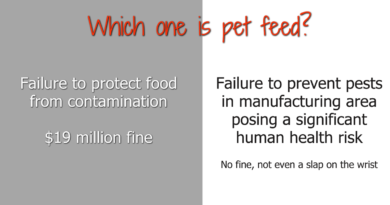FDA Admits Inactive Pets “cannot get enough required nutrients” From Pet Food – Truth about Pet Food
In recent months, veterinarian Dr. Karen Becker, pet food formulator Steve Brown, and myself have had two meetings with FDA regarding a serious concern of pet food. The concern we presented to FDA is nutritional deficiencies and excesses experienced by pets consuming less food (inactive pets) or more food (athlete pets). The FDA has just responded to our requests to alert pet owners, alert veterinarians and protect pets – denying or ignoring every single request we made.
The FDA has refused to warn pet owners…
But they did talk to select members of industry.
The FDA has refused to protect millions of US pets from nutritional deficiencies or excesses…
But they did take action to protect themselves.
We urgently need your help to force FDA to protect millions of US pets (see bottom of post).
The pet food problems:
In our meetings we asked the FDA to issue a public notice to alert pet owners and veterinarians to the nutrient deficiencies or nutrient excesses pets experience when consuming less food (inactive, overweight or senior pets) or when consuming more food (athlete pets).
As example, when a veterinarian instructs a pet owner to feed 1/4 less food per day to their inactive, overweight or senior cat or dog – that advice is highly likely to cause nutrient deficiencies in the pet. We evidenced this nutritional issue to FDA through actual nutritional analysis of multiple current brands of pet food. We used computer software to accurately prove a pet consuming as little as 1/4 less food (less calories) per day can result in protein, mineral and vitamin deficiencies.
We also exampled to FDA nutrient excesses in athlete or working pets that consume 50% or more pet food per day. We evidenced this nutritional issue to FDA through actual nutritional analysis of multiple current brands of pet food. We used computer software to accurately prove a pet consuming 50% more food (more calories) per day can result in mineral and vitamin excesses.
The FDA denied our request to warn pet owners and veterinarians.
But they took action to protect themselves.
During our first presentation we exampled an FDA webpage giving pet owners advice “to increase or cut back as needed” the amount of pet food provided.

After we proved that advice (“to increase or cut back” feeding amount) has detrimental consequences to pets, the FDA quietly removed the statement from their website protecting themselves while refusing to protect pet owners and veterinarians. Today that webpage looks like this:

(Pet owners can access the page FDA removed at Wayback Machine, Click Here.)
And then the FDA said this…
Several weeks after our second meeting with FDA, the agency provided us with their response (dated March 24, 2023).
“Regarding your concern about very calorically efficient pets requiring so little food to meet their individual calorie needs that they cannot get enough required nutrients in that amount of food, we too have considered this issue and have for several years had discussions with pet food manufacturers and the National Research Council.”
The FDA admitted a certain percentage of US pets “cannot get enough required nutrients” from their pet food.
The FDA admitted they “have for several years had discussions with pet food manufacturers” about this serious pet food issue.
But they have NEVER told you (pet owners) or your veterinarian.
This problem revolves around a pet’s “calorie needs“. The AAFCO Nutrient Profiles (adopted with direct FDA involvement and approval) are ONLY based on high calorie needs pets, AAFCO Nutrient Profiles completely ignore the calorie needs of inactive, overweight, senior or very active/working pets. The AAFCO Nutrient Profiles provide a Complete and Balanced diet if and only if the pet consumes the correct amount of pet food (again, a high calorie amount each day).
FDA and AAFCO are refusing to address the nutritional needs of pets that require less calories per day (inactive pets, overweight pets, and senior pets). (We asked the AAFCO Pet Food Committee to investigate this issue several years ago and AAFCO refused.)
How many pets is FDA ignoring the nutritional needs of?
Consulting AVMA dog and cat statistics in the US, and based on the Morris Animal Foundation statistic of overweight or obese pets – we estimate 43 million US dogs and 35 million US cats are at risk for nutrient deficiencies.
The FDA is refusing to develop nutritional protections for at least 78 million US pets that are consuming less food each day.
We (Dr. Karen Becker, Steve Brown, and myself) responded back to FDA asking them for some clarification. We asked the agency to respond to the following questions:
- Do manufacturer recommended feeding amounts of an AAFCO compliant Complete and Balanced pet food assure pet owners their pet’s nutritional needs are being met? Do manufacturer recommended feeding amounts assure pet owners their pet is consuming a complete and balanced diet?
- Are pet food manufacturers required to provide recommended feeding amounts that directly correlate to the nutritional adequacy statement on the label?
- If a senior pet or an overweight pet was instructed by their veterinarian to feed 25% less of an AAFCO compliant Complete and Balanced pet food per day (than the manufacturer recommended feeding amount), is that pet’s nutritional needs being met through their complete and balanced diet? Is there any risk of nutrient deficiencies when the pet consumes 25% less pet food?
- If an athlete pet consumed 50% more of an AAFCO compliant Complete and Balanced pet food per day (than the manufacturer recommended feeding amount), is that pet’s nutritional needs being met through their complete and balanced diet? Is there any risk of nutrient excesses when the pet consumes 50% more pet food?
- Has the FDA or AAFCO ever published pet owner or veterinarian educational material explaining that complete and balanced pet foods are directly related to a specific amount of calories consumed per day?
In my (Susan Thixton) experience as a consumer advocate, the truthful answer to these questions are:
- Manufacturer feeding amounts vary dramatically. Feeding directions do not guarantee pet owners their pet is consuming a complete and balanced diet.
- The regulations for manufacturer feeding directions are vague and do not directly correlate to the nutritional adequacy statement (such as Adult Maintenance).
- There are definite risks to nutrient deficiencies when inactive pets consume 25% less pet food.
- There are definite risks to nutrient excesses when athlete pets consume 50% more pet food.
- The FDA or AAFCO has NEVER provided any education to pet owners or veterinarians explaining complete and balanced is only complete and balanced when the correct amount of calories are consumed each day.
We also asked the FDA to disclose exactly which pet food manufacturers they “had discussions” with on this serious issue. Pet owners deserve to know exactly who FDA shared their secret pet food nutritional concerns with (the manufacturers who also kept the secret).
As it stands, the FDA Center for Veterinary Medicine has been aware “for several years” of these serious pet food nutritional issues but the agency has refused to establish Nutrient Profiles for inactive pets, refused to establish Nutrient Profiles for working/athlete pets, refused warn pet owners to potential (likely) nutrient deficiencies or excesses, refused to warn veterinarians, refused to require pet food feeding directions disclose the amount of food needed to be fed to achieve a complete and balanced diet, and the agency refused to strengthen feeding direction regulations.
Will the FDA respond to our questions? It’s unlikely. If they did respond, they would be forced to admit the problem. So…your help is needed.
Please send your Representatives in Congress the following message:
The FDA recently admitted to consumer advocates a large percentage of US pets (inactive, overweight and senior pets) “cannot get enough required nutrients” due to consuming less pet food per day. Further the FDA is refusing to publicly warn pet owners and veterinarians to the potentially serious health concerns of nutrient deficiencies caused by consuming less amounts of pet food. The agency does not respond (or promptly respond) to my emails, thus I am asking your office to request FDA CVM provide me responses to the following questions:
- Do manufacturer recommended feeding amounts of an AAFCO compliant Complete and Balanced pet food assure pet owners their pet’s nutritional needs are being met?
- Are pet food manufacturers required to provide recommended feeding amounts that directly correlate to the nutritional adequacy statement on the label?
- If a senior pet or an overweight pet was instructed by their veterinarian to feed 25% less of an AAFCO compliant Complete and Balanced pet food per day (than the manufacturer recommended feeding amount), is that pet’s nutritional needs being met through their complete and balanced diet? Is there any risk of nutrient deficiencies when the pet consumes 25% less pet food?
- If an athlete pet consumed 50% more of an AAFCO compliant Complete and Balanced pet food per day (than the manufacturer recommended feeding amount), is that pet’s nutritional needs being met through their complete and balanced diet? Is there any risk of nutrient excesses when the pet consumes 50% more pet food?
- Has the FDA or AAFCO ever published pet owner or veterinarian educational material explaining that complete and balanced pet foods are directly related to a specific amount of calories consumed per day?
If your Representatives in Congress asks the FDA to respond to these questions…the agency will be under great pressure to respond. If you don’t receive an FDA response within 2 weeks, email your Representatives again alerting them the FDA has not responded.
This problem in pet food MUST be corrected. Clearly the FDA has no current intentions to do the right thing, so we need many, many pet owners to help nudge them in the right direction (fixing this serious problem). Please send your emails and ask every pet owner you know to do the same.
Should we (Dr. Karen Becker, Steve Brown, and myself) hear anything from FDA – we will share with pet owners.
If you would like to read our full response to FDA, Click Here.
Wishing you and your pet(s) the best,
Susan Thixton
Pet Food Safety Advocate
Author Buyer Beware, Co-Author Dinner PAWsible
TruthaboutPetFood.com
Association for Truth in Pet Food

Become a member of our pet food consumer Association. Association for Truth in Pet Food is a a stakeholder organization representing the voice of pet food consumers at AAFCO and with FDA. Your membership helps representatives attend meetings and voice consumer concerns with regulatory authorities. Click Here to learn more.
What’s in Your Pet’s Food?
Is your dog or cat eating risk ingredients? Chinese imports? Petsumer Report tells the ‘rest of the story’ on over 5,000 cat foods, dog foods, and pet treats. 30 Day Satisfaction Guarantee. Click Here to preview Petsumer Report. www.PetsumerReport.com
Find Healthy Pet Foods in Your Area Click Here

The 2023 List
Susan’s List of trusted pet foods. Click Here to learn more.




